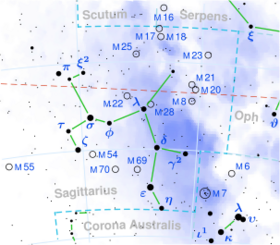Astronomy:52 Sagittarii
| Observation data Equinox J2000.0]] (ICRS) | |
|---|---|
| Constellation | Sagittarius |
| Right ascension | 19h 36m 42.43288s[1] |
| Declination | −24° 53′ 01.0288″[1] |
| Apparent magnitude (V) | 4.59[2] + 9.2 |
| Characteristics | |
| Evolutionary stage | main sequence[3] |
| Spectral type | B8/9V[4] + K2–4V |
| U−B color index | −0.15[5] |
| B−V color index | −0.06[5] |
| Astrometry | |
| Radial velocity (Rv) | −19.00[6] km/s |
| Proper motion (μ) | RA: +68.30[1] mas/yr Dec.: −21.51[1] mas/yr |
| Parallax (π) | 17.20 ± 0.23[1] mas |
| Distance | 190 ± 3 ly (58.1 ± 0.8 pc) |
| Absolute magnitude (MV) | 0.77[2] |
| Details | |
| 52 Sgr A | |
| Mass | 3.0±0.1[7] M☉ |
| Radius | 2.1[8] R☉ |
| Luminosity | 60.5+1.9 −1.8[3] L☉ |
| Surface gravity (log g) | 4.19[9] cgs |
| Temperature | 10,592+74 −72[3] K |
| Metallicity [Fe/H] | 0.00[10] dex |
| Rotational velocity (v sin i) | 48[3] km/s |
| Age | 57.3±11.7[7] Myr |
| Other designations | |
| Database references | |
| SIMBAD | data |
52 Sagittarii is a binary star[12] system in the southern constellation of Sagittarius. It has the Bayer designation h2 Sagittarii, while 52 Sagittarii is the Flamsteed designation. This system is visible to the naked eye as a faint, blue-white hued point of light with an apparent visual magnitude of 4.59.[2] It is located approximately 190 light years away based on parallax,[1] but is drifting closer with a radial velocity of −19 km/s.[6]
The primary component is a B-type main-sequence star with a stellar classification of B8/9V.[4] Garrison and Gray (1994) assigned it a class of kB8 hB9 HeA0 Va (Sr Fe II),[13] displaying the calcium K line of a B8 class star, the hydrogen lines of a B9 star, and the helium lines of an A0 star, along with overabundances of strontium and iron. It is around 57[7] million years old with three[7] times the mass of the Sun and about 2.1[8] times the Sun's radius. It is radiating 60.5[3] times the luminosity of the Sun from its photosphere at an effective temperature of 10,592 K.[3] The star is spinning with a projected rotational velocity of 48 km/s.[3]
52 Sagittarii has one companion at an angular separation of 2.4″. This object is magnitude 9.2 with a spectral class in the K2V-K4V range, and is believed to be the source of X-ray emissions from the system.[14][15]
References
- ↑ 1.0 1.1 1.2 1.3 1.4 1.5 Van Leeuwen, F. (2007). "Validation of the new Hipparcos reduction". Astronomy and Astrophysics 474 (2): 653–664. doi:10.1051/0004-6361:20078357. Bibcode: 2007A&A...474..653V. Vizier catalog entry
- ↑ 2.0 2.1 2.2 Anderson, E.; Francis, Ch. (2012). "XHIP: An extended hipparcos compilation". Astronomy Letters 38 (5): 331. doi:10.1134/S1063773712050015. Bibcode: 2012AstL...38..331A. Vizier catalog entry
- ↑ 3.0 3.1 3.2 3.3 3.4 3.5 3.6 Zorec, J.; Royer, F. (2012). "Rotational velocities of A-type stars". Astronomy & Astrophysics 537: A120. doi:10.1051/0004-6361/201117691. Bibcode: 2012A&A...537A.120Z. Vizier catalog entry
- ↑ 4.0 4.1 Houk, Nancy; Smith-Moore, M. (1978). Michigan catalogue of two-dimensional spectral types for the HD stars. 4. Ann Arbor: Dept. of Astronomy, University of Michigan. Bibcode: 1988mcts.book.....H.
- ↑ 5.0 5.1 Mallama, A. (2014). "Sloan Magnitudes for the Brightest Stars". The Journal of the American Association of Variable Star Observers 42 (2): 443. Bibcode: 2014JAVSO..42..443M.Vizier catalog entry
- ↑ 6.0 6.1 Wilson, R. E. (1953). "General Catalogue of Stellar Radial Velocities". Carnegie Institute Washington D.C. Publication (Carnegie Institution for Science). Bibcode: 1953GCRV..C......0W.
- ↑ 7.0 7.1 7.2 7.3 Tetzlaff, N. et al. (2011). "A catalogue of young runaway Hipparcos stars within 3 kpc from the Sun". Monthly Notices of the Royal Astronomical Society 410 (1): 190–200. doi:10.1111/j.1365-2966.2010.17434.x. Bibcode: 2011MNRAS.410..190T. Vizier catalog entry
- ↑ 8.0 8.1 Allende Prieto, C.; Lambert, D. L. (1999). "Fundamental parameters of nearby stars from the comparison with evolutionary calculations: Masses, radii and effective temperatures". Astronomy and Astrophysics 352: 555–562. Bibcode: 1999A&A...352..555A. Vizier catalog entry
- ↑ David, Trevor J.; Hillenbrand, Lynne A. (2015). "The Ages of Early-Type Stars: Strömgren Photometric Methods Calibrated, Validated, Tested, and Applied to Hosts and Prospective Hosts of Directly Imaged Exoplanets". The Astrophysical Journal 804 (2): 146. doi:10.1088/0004-637X/804/2/146. Bibcode: 2015ApJ...804..146D. Vizier catalog entry
- ↑ Gontcharov, G. A. (2012). "Dependence of kinematics on the age of stars in the solar neighborhood". Astronomy Letters 38 (12): 771–782. doi:10.1134/S1063773712120031. Bibcode: 2012AstL...38..771G. Vizier catalog entry
- ↑ "h02 Sgr". SIMBAD. Centre de données astronomiques de Strasbourg. http://simbad.u-strasbg.fr/simbad/sim-basic?Ident=h02+Sgr.
- ↑ Eggleton, P. P.; Tokovinin, A. A. (September 2008). "A catalogue of multiplicity among bright stellar systems". Monthly Notices of the Royal Astronomical Society 389 (2): 869–879. doi:10.1111/j.1365-2966.2008.13596.x. Bibcode: 2008MNRAS.389..869E.
- ↑ Garrison, R. F.; Gray, R. O. (1994). "The late B-type stars: Refined MK classification, confrontation with stromgren photometry, and the effects of rotation". The Astronomical Journal 107: 1556. doi:10.1086/116967. Bibcode: 1994AJ....107.1556G. Garrison has note: "Balmer shell cores?"
- ↑ Hubrig, S. et al. (2007). "Establishing the nature of companion candidates to X-ray-emitting late B-type stars". Monthly Notices of the Royal Astronomical Society 381 (4): 1569. doi:10.1111/j.1365-2966.2007.12325.x. Bibcode: 2007MNRAS.381.1569H.
- ↑ Mason, Brian D. et al. (2001). "The 2001 US Naval Observatory Double Star CD-ROM. I. The Washington Double Star Catalog". The Astronomical Journal 122 (6): 3466. doi:10.1086/323920. Bibcode: 2001AJ....122.3466M. Vizier catalog entry
 |


